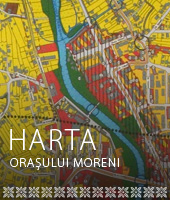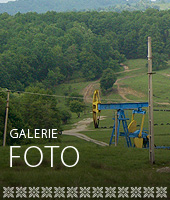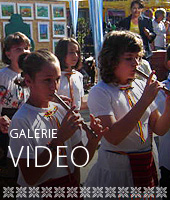Events Calendar
vizite
This area belongs to the basin of Ialomita River being the main collector in the village Cricov. Hydrographic regime was influenced by landscape fragmentation, climate, geology. Food has a pluvio-Nivala, with spring waters resulting from rainfall and snowmelt and summer floods caused by torrential rains.
Groundwater depend on the degree of permeability and thickness of rocks. It is noted three categories of groundwater: groundwater, deep groundwater, springs.
The groundwater is found at great depths. Cricovului meadow alluvium aquifer is confined to the terrace, but the supply of water through wells is no longer due to oil exploitation and placing salt in layers. Drinking water crisis prompted the City Moreni to drill wells and introduce piped water supply.
The groundwater canal is encountered at great depths. In the meadow of Cricov the phreatic water is cantoned in the terraced alluviums, but the water supply through the wells is no longer due to the exploitation of the oil and the introduction of salt into layers. The drinking water crisis has triggered Moreni City Hall to drill wells and introduce piped water supply. After "superficial water works were made at Tisa", on 12 December 1943 "the foundation stone was laid at the house of the new water station of the commune, in the basement." The economic development of the locality has led to new investments, the water supply being made from the accumulation lake Paltinul (Prahova), a work executed after 1975 and from the wells of Lazuri and Săcuieni (work done after 1980 for the Production Schedule and the supply of the Schela Mare neighborhood ). In 1987 new drillings were made at "Tisza" and "in Podei" to put into operation another 8 drinking water extraction wells. The Moreni water supply sources are: 14 l / s, which pumps water through a 300 mm pipeline into the two Bna reservoirs with a storage capacity of 1000 m3; Paltinul provides 70 l / s through a 400 mm pipe and 10 l / s floor. The ground source pumps the water into a 30 m3 tank in the Plai district, serving the NE of the city.
Deep underground waters are underground only in the northern part of the locality and in the southern area are non-existent due to the geo-lithological conditions that have not facilitated their accumulation and circulation.
The only occurrences of water occur in the form of springs, the best known being the "Fountain of Tudor" and "Pâscov", which feed the cross with the same name (became Cernea to spill), "Sângeriş", "Bana", "Dobreşti" Peace, "which flows to the left in the Cricov bed. On the right side of Cricov there is the Tisa brook with which he runs parallel a good amount of time capturing it in the northern part of the locality. Also on the right side, Cricovul also receives "The Fouureasa" and "Frasinul".
Besides the waters of these valleys, Cricov has a series of valleys of the size of some viroges of great importance through their torrential character.
Also, in the area of Moreni, there is a stagnation of the water coming from the slope, due to the deluvial clay layer, impermeable to its surface and to the low or non-existent slope (Stadion area, Republic Square area, Gara area, south Street Unirii).
The groundwater horizon is cantonated in the fine and coarse alluvial deposits of Cricov, from the base of the terraces, situated at varying depths depending on the morphology of the terrain. Thus, north of the town of Moreni, it has good drinking characteristics, while south due to infestation with oil products and reservoir waters, they become unpopular.
Deep aquifer layers have met in the Iedera area up to 150m - with good drinking characteristics. In the areas where the diluent is thick (the average terrace to the Bana slope), the phreatic is slightly ascendant. Deepwater layers were intercepted in the Ghirdoveni synclinal, but the water has increased salinity due to the presence of the salt pillar upstream. The direction of the phreatic flow is consistent with the general slope of the terrain, being drained by the Cricov bed at the minimum water levels on it. The erosion of Cricov is done both vertically and horizontally. Especially after the rain we can see how the river carries the eroded material and where the slope is more quiet (from the center of the city to the south) some of this material is deposited as alluviums. Throughout Cricov from the Moreni rayon we can observe the presence of lateral erosion. Cricovul has a multi-annual flow rate of 2.60 m3 / s, corresponding to an area of 544 km2 and an average altitude of the 391 m river basin, about the average altitude of the locality. As a result of the ratio between the amount of precipitation and the set of geographic conditions, the specific average leakage is 4 l / s km2 in the North, increasing insignificantly to the South due to the fact that the contribution of the tributaries is generally reduced.
As far as the winter phenomena are concerned, it is found that they last for 40-60 days a year, rarely freezing the entire course of the river (especially when winter follows a poor autumn in precipitation). Analyzing the slurry spillage, a massive increase is observed in the area of the locality, reaching 5 - 20 t / ha year; Maximum being during floods. The degree of mineralization is quite high, and Cricov transports chlorinated water, with values between 500-1000 mg / l. The fact that bicarbonate waters have become chlorinated is due not only to natural factors (the intersection of diaphoresis) but also to human intervention (the discharge into the river of reservoir waters from petroleum exploitation, domestic water making the river inappropriate for life, especially in the inhabited part of Settlement).










